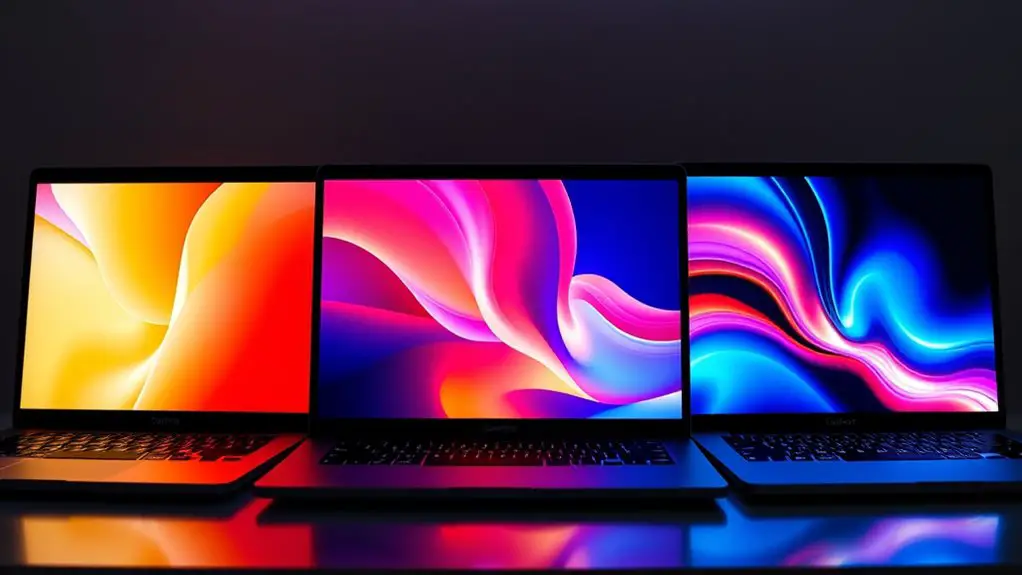The evolution of laptop displays has transformed dramatically from Twisted Nematic (TN) panels, known for their speed but lacking in color accuracy, to In-Plane Switching (IPS), which offers vibrant colors and wide viewing angles. Now, Organic Light Emitting Diodes (OLED) stand out with their stunning color depth and contrast but face issues like burn-in. Each technology has its pros and cons, shaping your decision on what to prioritize in a laptop display. There's much more to explore about these advancements.
The Rise of Twisted Nematic (TN) Panels
As technology evolved, Twisted Nematic (TN) panels emerged as a popular choice for budget-conscious consumers seeking decent performance in their laptops. Their historical significance lies in their rapid adoption during the early 2000s, providing an affordable solution for casual users and gamers alike. However, you should be aware of their technological limitations; TN panels typically struggle with color accuracy and viewing angles compared to their counterparts. While they excel in response times, making them ideal for fast-paced gaming, the trade-offs in visual quality can hinder a more immersive experience. Understanding these factors is essential for making informed decisions, especially if you value both performance and visual fidelity in your laptop display.
The Colorful World of In-Plane Switching (IPS)
While TN panels paved the way for budget-friendly laptops, In-Plane Switching (IPS) technology has taken the display market by storm, offering a vibrant and visually stunning alternative. IPS panels excel in color accuracy and viewing angles, making them a favorite among creatives and gamers alike. With their ability to reproduce true-to-life colors from nearly any angle, you'll find that your experience is more immersive and enjoyable.
| Feature | IPS Panels |
|---|---|
| Color Accuracy | Excellent |
| Viewing Angles | Wide |
| Response Time | Moderate |
If you prioritize rich visuals and consistent performance, IPS displays provide the freedom to enjoy content without compromising quality. Embrace the colorful world of IPS technology!
The Emergence of Organic Light Emitting Diodes (OLED)
With the rapid advancements in display technology, Organic Light Emitting Diodes (OLED) have emerged as a game-changer in the laptop market. OLED technology offers vibrant colors, deep blacks, and wide viewing angles, making it ideal for multimedia and creative applications. You'll appreciate how OLED applications enhance everything from gaming to graphic design, providing an immersive experience that traditional displays struggle to match. However, OLED isn't without its challenges. Issues like burn-in and shorter lifespan compared to other technologies can be concerning. Despite these drawbacks, the advantages of OLED—such as energy efficiency and improved contrast—continue to drive its popularity. As you explore your options, understanding these factors will help you make an informed decision on your next laptop display.
Comparing Display Technologies: Pros and Cons
When evaluating laptop displays, it's essential to weigh the pros and cons of different technologies, including TN, IPS, and OLED. TN panels typically offer high refresh rates and decent display brightness but fall short on color accuracy and viewing angles. IPS technology enhances color reproduction and viewing angles, making it ideal for creative work, though it might sacrifice some refresh rate performance. On the other hand, OLED displays shine with outstanding color accuracy and deep blacks, but they can be more expensive and may face burn-in issues over time. Ultimately, your choice should align with your priorities, whether you value vibrant colors, rapid refresh rates, or exceptional viewing angles for your laptop experience.
The Future of Laptop Displays: Trends and Innovations
As technology evolves, the landscape of laptop displays is set to undergo significant transformations, driven by emerging trends and innovations. You'll see future technologies like mini-LED and micro-OLED emerge, offering vibrant colors and deeper blacks, enhancing your viewing experience. The rise of flexible displays is also on the horizon, allowing for more portable and adaptable designs that cater to your mobility needs. Additionally, advancements in refresh rates and resolutions will make gaming and professional tasks more immersive than ever. With sustainability becoming a priority, expect eco-friendly materials and energy-efficient technologies to dominate the market. Ultimately, these display innovations will not only elevate performance but also empower you with greater freedom and versatility in your daily computing.
Frequently Asked Questions
How Do Different Display Technologies Affect Battery Life in Laptops?
Different display technologies greatly impact battery consumption. You'll find that displays with higher efficiency, like IPS and OLED, can enhance your laptop's battery life, allowing you more freedom to work or play without frequent recharging.
Can I Upgrade My Laptop's Display Technology?
You can upgrade your laptop's display technology, but there're limitations. Check for display compatibility options first; not all models support newer technologies. Weigh the benefits against the potential costs and technical challenges before deciding.
What Is the Lifespan of Each Display Type?
Imagine your screen glowing brightly; display longevity varies. TN panels last around 3-5 years, while IPS can go 5-7, and OLEDs shine for 5-8. Consider technology durability when investing in your next laptop.
Are There Health Concerns With Prolonged Laptop Display Use?
Prolonged laptop use can lead to eye strain, primarily due to blue light exposure. To minimize discomfort, consider taking regular breaks, adjusting brightness, and using blue light filters, ensuring a healthier viewing experience for your eyes.
How Do Ambient Light Conditions Impact Display Performance?
When it comes to ambient light, you've got to see the writing on the wall. Poor lighting can hinder display performance, causing glare and reducing visibility, while ideal conditions enhance clarity and color accuracy.

